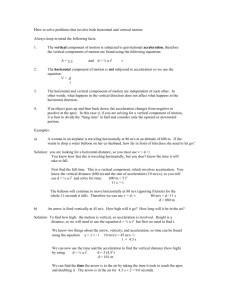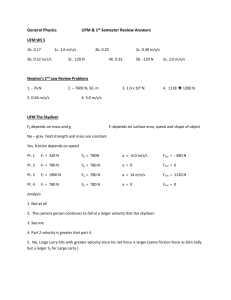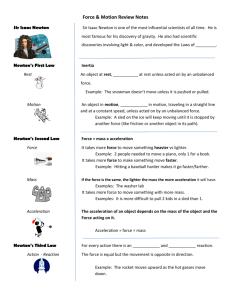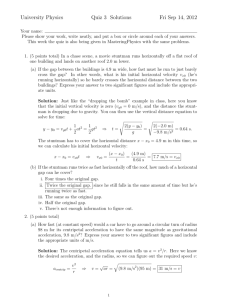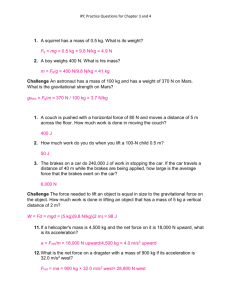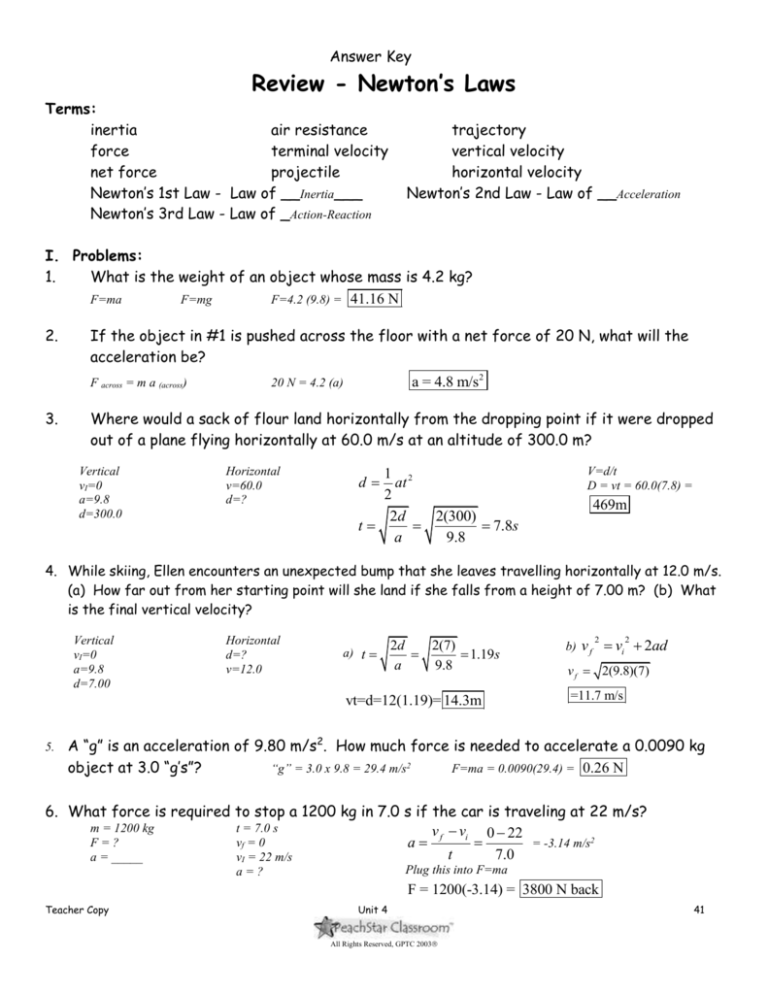
Answer Key
Review - Newton’s Laws
Terms:
inertia
air resistance
force
terminal velocity
net force
projectile
Newton’s 1st Law - Law of __Inertia___
Newton’s 3rd Law - Law of _Action-Reaction
trajectory
vertical velocity
horizontal velocity
Newton’s 2nd Law - Law of __Acceleration
I. Problems:
1.
What is the weight of an object whose mass is 4.2 kg?
F=ma
F=mg
F=4.2 (9.8) = 41.16 N
2.
If the object in #1 is pushed across the floor with a net force of 20 N, what will the
acceleration be?
F across = m a (across)
3.
a = 4.8 m/s2
20 N = 4.2 (a)
Where would a sack of flour land horizontally from the dropping point if it were dropped
out of a plane flying horizontally at 60.0 m/s at an altitude of 300.0 m?
Vertical
vI=0
a=9.8
d=300.0
Horizontal
v=60.0
d=?
V=d/t
D = vt = 60.0(7.8) =
1 2
at
2
2d
2(300)
t
7.8s
a
9.8
d
469m
4. While skiing, Ellen encounters an unexpected bump that she leaves travelling horizontally at 12.0 m/s.
(a) How far out from her starting point will she land if she falls from a height of 7.00 m? (b) What
is the final vertical velocity?
Vertical
vI=0
a=9.8
d=7.00
Horizontal
d=?
v=12.0
a) t
2d
2(7)
1.19s
a
9.8
vt=d=12(1.19)= 14.3m
5.
b)
v f vi 2ad
2
2
v f 2(9.8)(7)
=11.7 m/s
A “g” is an acceleration of 9.80 m/s2. How much force is needed to accelerate a 0.0090 kg
object at 3.0 “g’s”?
“g” = 3.0 x 9.8 = 29.4 m/s2
F=ma = 0.0090(29.4) = 0.26 N
6. What force is required to stop a 1200 kg in 7.0 s if the car is traveling at 22 m/s?
m = 1200 kg
t = 7.0 s
v f vi 0 22
F=?
vf = 0
a
= -3.14 m/s2
t
7.0
a = _____
vI = 22 m/s
Plug this into F=ma
a=?
F = 1200(-3.14) = 3800 N back
Teacher Copy
Unit 4
All Rights Reserved, GPTC 2003
41
7.
Answer Key
a. What is the acceleration of a falling skydiver (mass 72 kg including the parachute)
when the upward force of air resistance is equal to ¼ of her total weight?
Fair = 706/4 = 176 N
Fwt = 706 N
Fnet = big – little
Fnet = 706-176 = 530
N
Fnet = ma
a = F/m = 530/72 = 7.4 m/s 2
b. Shortly after opening her parachute, the skydiver descends to the ground at constant
velocity. What is the air resistance on her now?
Fnet=0 so Fair = Fst = 710 N (rounded to 2 digits)
8.
A stone is thrown horizontally at 8.0 m/s from the edge of a cliff 78 m high. How far
from the base of the cliff does the ball land?
Horizontal
Vertical
v=d/t
2d
v = 8.0 m/s
d = 78 m
d = vt
= 4.00 s
t
a
d=?
a = 9.8 m/s2
d=8.0(4.00) = 32 m
t = _____
vi = 0
t = ______
Plug this in to
horizontal
II. The following statements are false. Tell what is wrong with each or change it
to a true statement.
1.
An object always moves accelerates in the direction of the net force applied to it.
2.
A horse must pull a cart harder than the cart pulls back on the horse to move forward.
The horse must push back on the ground to move the cart.
3.
Action-reaction forces cancel out so that neither object can accelerate. They don’t cancel
because they act on different objects.
4.
When a car hits a bug, the bug hits back with the same force and both car and bug
accelerate equally. The bug accelerates more because it has less mass (inertia).
5.
If everyone inside a car pushes forward on the car, they can make the car speed up. No –
you must have an external force.
6.
To hit a distant target with an arrow, Robin Hood should aim directly at the target. Aim
above it because gravity will pull it down as it moves horizontally.
7.
A feather and a hammer will fall with the same acceleration in a vacuum because there is
no gravity air in a vacuum. There is gravity! You won’t fall without it.
8.
The real reason for #7 is that gravity pulls the feather and the hammer with the same
force acceleration. They have different weights.
Teacher Copy
Unit 4
All Rights Reserved, GPTC 2003
41
Answer Key
9.
When the human cannonball leaves the barrel of the cannon, his horizontal motion is
accelerated uniform and his vertical motion is uniform accelerated.
Teacher Copy
Unit 4
All Rights Reserved, GPTC 2003
41




